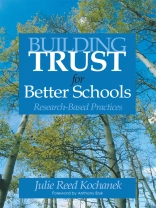‘While trust has been shown as a key mechanism for facilitating school improvement, how that can be accomplished is not altogether clear. In this excellent book, Kochanek, through in-depth case studies and sophisticated quantitative analyses of data from a large urban school system, convincingly demonstrates how principal leadership can promote and sustain trust among administrators, teachers, and parents.’
-Barbara Schneider, Professor of Sociology
University of Chicago
‘Kochanek′s book not only clearly explains the theoretical underpinnings of trust development in schools, but also provides rich case studies that explore this theory in action.’
-Carmen Manning, Assistant Professor of English Education
University of Wisconsin-Eau Claire
Why is trust in schools so important? What does trust mean to a school′s productivity?
Relationships between principals, teachers, and parents cannot be ignored when attempting school reform. No matter how innovative the changes or ideas, reform is unlikely to succeed unless the adults work together to implement it.
Building Trust for Better Schools answers the question of how to build trust within the school community.
Parents are dependent on teachers to educate their children. Teachers are dependent on principals to create school conditions that are conducive to helping children learn. This excellent new resource identifies links between the growth of trust and positive organizational outcomes that benefit school improvement efforts.
But how do we build trust? Kochanek offers an innovative process model of trust building. Increased trust in schools:
- Fosters participation among faculty in school reform efforts
- Creates a greater openness to innovation among teachers
- Increases outreach to parents
- Produces even higher academic productivity in schools
表中的内容
Foreword – Anthony S. Bryk
Preface
Acknowledgments
About the Author
1. Introduction: Making a Case for Trust
Why Is Trust in Schools So Important?
Efficient Schools as Network Organizations
How Is Trust Defined in Schools?
What Do We Know About Building Trust?
Summary
2. Trust Building as a Developmental Process
Setting the Stage for Positive Interactions
Fostering Low-Risk Exchanges
Creating Opportunities for High-Risk Interactions
Illustrating a Model With Case Studies
3. Mac Neil Elementary School: Improving a High-Trust School
The Principal in the Office
New Leadership: The People′s Principal
Refining Relationships for Higher Levels of Trust
Summary
4. Mills Elementary School: Starting From a Lack of Trust
A School in Conflict
A Principal Under Siege
Developing Relationships From the Lowest Levels of Trust
Summary
5. Cole Magnet Elementary School: Coming Back to Trust
A Temporary Intrusion
Returning to Normal: The Maintenance Principal
Shared Governance, Facilitated Relationships, and a Lack of Direction
Summary
6. An Examination of Trust Building Through Quantitative Analyses
How Does a Low Base State of Trust Affect the Effectiveness of Trust-Building Strategies?
In Schools With Growing Parent-Teacher Trust, How Does Parent Involvement Vary With the Economic Level of the Parents?
How Important Is a Buffer Between Teachers and Parents in Schools Where Parental Involvement Is Strong?
Does the Growth of Teacher-Principal Trust Lead to a Growth in Teacher-Teacher Trust?
Summary
7. Implementing Trust-Building Strategies in Your School
Which Strategies Are Effective in Building Trust?
Conclusion
Resource A: CCSR Relational Trust Measures
Resource B: Measures of Key Concepts of Trust Building
References
Index
关于作者
Julie Reed Kochanek received her Ph.D from the University of Chicago in 2003. She is currently an assistant professor of sociology at Southern Oregon University in Ashland, Oregon.












